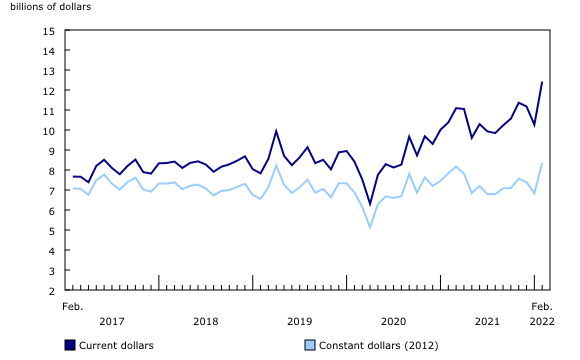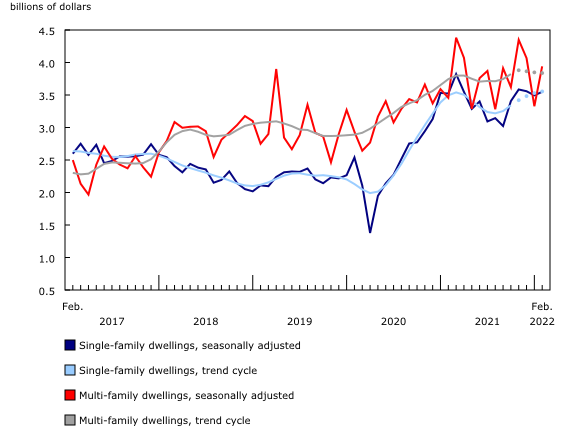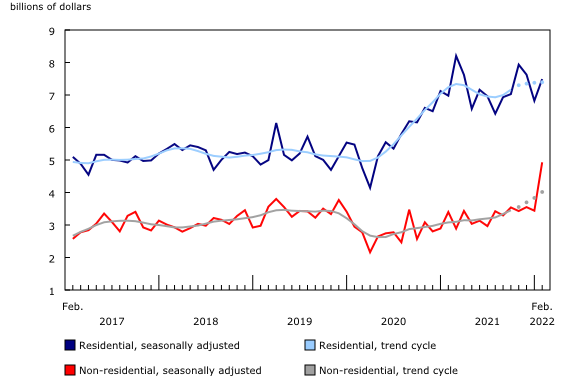Building permits, February 2022
Archived Content
Information identified as archived is provided for reference, research or recordkeeping purposes. It is not subject to the Government of Canada Web Standards and has not been altered or updated since it was archived. Please "contact us" to request a format other than those available.
Released: 2022-04-04
$12.4 billion
February 2022
21.0% 
(monthly change)
$47.1 million
February 2022
54.3% 
(monthly change)
$68.9 million
February 2022
77.4% 
(monthly change)
$215.6 million
February 2022
18.1% 
(monthly change)
$141.5 million
February 2022
38.9% 
(monthly change)
$2,583.9 million
February 2022
1.1% 
(monthly change)
$4,340.4 million
February 2022
1.2% 
(monthly change)
$416.9 million
February 2022
57.5% 
(monthly change)
$150.2 million
February 2022
-8.7% 
(monthly change)
$1,218.0 million
February 2022
-1.7% 
(monthly change)
$3,206.8 million
February 2022
130.2% 
(monthly change)
$8.5 million
February 2022
252.9% 
(monthly change)
$6.2 million
February 2022
383.5% 
(monthly change)
$14.2 million
February 2022
...%
(monthly change)
The total value of building permits rose 21.0% to a record $12.4 billion in February, with British Columbia (+130.2%) leading the way. Construction intentions in the residential sector were up 9.8%, while the non-residential sector jumped 43.2%, driven mainly by large hospital permits in British Columbia and Quebec.
On a constant dollar basis (2012=100), the total value of building permits increased 22.1% in February.
Residential sector up in February
Construction intentions in February for the residential sector rose 9.8% to $7.5 billion at the national level, with nine provinces reporting gains.
Gains in multi-family permit values in British Columbia (+57.9%) reversed January's decline and contributed to the 18.5% increase at the national level, along with the gains in seven other provinces.
The total value of single family home permits rose 1.5% in February. Seven provinces reported increases.
Large hospital permits push non-residential sector to new heights
The total value of non-residential building permits surged 43.2% to $4.9 billion in February, largely reflecting large hospital permits in British Columbia and Quebec worth a combined $1.9 billion.
Construction intentions in the institutional component jumped 216.4% for the month, largely reflecting the $1.5 billion St. Paul's Hospital project in Vancouver. Additionally, the $439 million permit for the second phase of le nouveau complexe hospitalier du CHU de Québec also contributed notably to this component.
The value of commercial permits gained 5.6% in February at the national level, with six provinces reporting increases. A $112 million Wawanesa Insurance office headquarters project caused the value of commercial permits in Manitoba to jump 337.4%.
The total value of industrial building intentions fell 27.9% mostly due to declines in Quebec (-44.8%) and Ontario (-28.8%).
To explore data using an interactive user interface, visit the Building permits: Interactive Dashboard.
To explore the impact of COVID-19 on the socioeconomic landscape, please consult the Canadian Economic Dashboard and COVID-19.
For more information on housing, please visit the Housing statistics portal.
Statistics Canada has a Housing Market Indicators dashboard. This web application provides access to key housing market indicators for Canada, by province and by census metropolitan area. These indicators are updated automatically with new information from monthly releases, giving users access to the latest data.
Note to readers
As of February 1, 2022, the Building Permits Survey introduced an electronic questionnaire to replace older collection methods such as paper questionnaires, faxes and emails. As Statistics Canada migrates to this new system, data included in this release may see larger than normal monthly revisions.
Unless otherwise stated, this release presents seasonally adjusted data with current dollar values, which facilitate month-to-month and quarter-to-quarter comparisons by removing the effects of seasonal variations. For information on seasonal adjustment, see Seasonally adjusted data – Frequently asked questions.
Starting with the March 2021 reference period, monthly constant dollar estimates are available for the entire data series (34-10-0066-01). Constant dollars remove the effects of price changes over time and are calculated using quarterly deflators from the Building Construction Price Index (18-10-0135-01). Typically, the first two months of a quarter use the previous quarter's price level and are revised when the new quarterly price index becomes available.
Building components
- Single-family dwellings: Residential buildings containing only one dwelling unit (e.g., single-detached house, bungalow, linked home [linked at the foundation]).
- Multi-family dwellings: Residential buildings containing multiple dwelling units (e.g., apartment, apartment condominium, row house, semi-detached house).
- Industrial buildings: Buildings used in the processing or production of goods, or related to transportation and communication.
- Commercial buildings: Buildings used in the trade or distribution of goods and services, including office buildings.
- Institutional and government buildings: Buildings used to house public and semi-public services, such as those related to health and welfare, education, or public administration, as well as buildings used for religious services.
Revision
Unadjusted data for the current reference month are subject to revisions based on late responses. Data for the two previous months have been revised. Seasonally adjusted data for the previous three months have also been revised.
Trend-cycle estimates have been added to the charts as a complement to the seasonally adjusted series. Both seasonally adjusted data and trend-cycle estimates are subject to revision as additional observations become available. These revisions could be large and could even lead to a reversal of movement, especially at the end of the series. The higher variability associated with trend-cycle estimates is indicated with a dotted line on the charts.
For information on trend-cycle data, see the StatCan Blog and Trend-cycle estimates – Frequently asked questions.
Next release
Data on building permits for March will be released on May 9.
Contact information
For more information, or to enquire about the concepts, methods or data quality of this release, contact us (toll-free 1-800-263-1136; 514-283-8300; infostats@statcan.gc.ca) or Media Relations (statcan.mediahotline-ligneinfomedias.statcan@statcan.gc.ca).
- Date modified:





